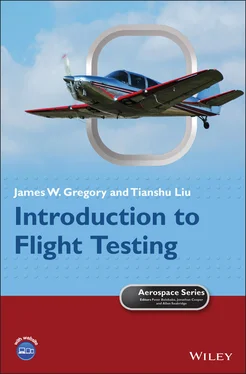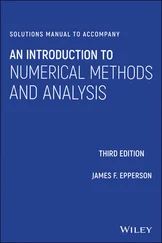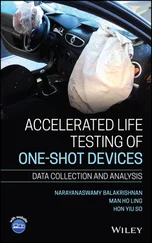1 Cover
2 Series Page
3 Title Page
4 Copyright
5 dedication
6 About the Authors
7 Series Preface
8 Preface
9 Acknowledgements
10 About the Companion Website
11 1 Introduction 1.1 Case Study: Supersonic Flight in the Bell XS‐1 1.2 Types of Flight Testing 1.3 Objectives and Organization of this Book References
12 2 The Flight Environment: Standard Atmosphere 2.1 Earth's Atmosphere 2.2 Standard Atmosphere Model 2.3 Altitudes Used in Aviation References Notes
13 3 Aircraft and Flight Test Instrumentation 3.1 Traditional Cockpit Instruments 3.2 Glass Cockpit Instruments 3.3 Flight Test Instrumentation 3.4 Summary References Note
14 4 Data Acquisition and Analysis 4.1 Temporal and Spectral Analysis 4.2 Filtering 4.3 Digital Sampling: Bit Depth Resolution and Sample Rate 4.4 Aliasing 4.5 Flight Testing Example 4.6 Summary References
15 5 Uncertainty Analysis 5.1 Error Theory 5.2 Basic Error Sources in Flight Testing References
16 6 Flight Test Planning 6.1 Flight Test Process 6.2 Risk Management 6.3 Case Study: Accept No Unnecessary Risk 6.4 Individual Flight Planning 6.5 Conclusion References
17 7 Drag Polar Measurement in Level Flight 7.1 Theory 7.2 Flight Testing Procedures 7.3 Flight Test Example: Cirrus SR20 References Note
18 8 Airspeed Calibration 8.1 Theory 8.2 Measurement Errors 8.3 Airspeed Calibration Methods 8.4 Flight Testing Procedures 8.5 Flight Test Example: Cirrus SR20 References Note
19 9 Climb Performance and Level Acceleration to Measure Excess Power 9.1 Theory 9.2 Flight Testing Procedures 9.3 Data Analysis 9.4 Flight Test Example: Cirrus SR20 References
20 10 Glide Speed and Distance 10.1 Theory 10.2 Flight Testing Procedures 10.3 Data Analysis 10.4 Flight Test Example: Cirrus SR20 References
21 11 Takeoff and Landing 11.1 Theory 11.2 Measurement Methods 11.3 Flight Testing Procedures 11.4 Flight Test Example: Cessna R182 References Notes
22 12 Stall Speed 12.1 Theory 12.2 Flight Testing Procedures 12.3 Data Analysis 12.4 Flight Test Example: Cirrus SR20 References
23 13 Turning Flight 13.1 Theory 13.2 Flight Testing Procedures 13.3 Flight Test Example: Diamond DA40 References
24 14 Longitudinal Stability 14.1 Static Longitudinal Stability 14.2 Dynamic Longitudinal Stability References
25 15 Lateral‐Directional Stability 15.1 Static Lateral‐Directional Stability 15.2 Dynamic Lateral‐Directional Stability Nomenclature Acronyms and Abbreviations References
26 16 UAV Flight Testing 1 16.1 Overview of Unmanned Aircraft 16.2 UAV Design Principles and Features 16.3 Flight Regulations 16.4 Flight Testing Principles 16.5 Flight Testing Examples with the Peregrine UAS 16.6 Flight Testing Examples with the Avanti UAS 16.7 Conclusion References Notes
27 Appendix A: Appendix AStandard Atmosphere Tables
28 Appendix B: Appendix BUseful Constants and Unit Conversion Factors Reference
29 Appendix C: Appendix CStability and Control Derivatives for a Notional GA Aircraft Reference
30 Index
31 End User License Agreement
1 Chapter 1 Table 1.1 Airworthiness certification levels defined by part 23.
2 Chapter 2 Table 2.1 Definition of temperature lapse rates in various regions of the atm... Table 2.2 Constants used in Sutherland's Law.
3 Chapter 3Table 3.1 DAQ sensor utility matrix.
4 Chapter 5Table 5.1 Typical uncertainty values for an airspeed indicator.Table 5.2 Maximum scale error permitted by 14 CFR 43 Appendix E.Table 5.3 Maximum friction error permitted by 14 CFR 43 Appendix E.Table 5.4 Maximum barometric scale error permitted by 14 CFR 43 Appendix E.
5 Chapter 6Table 6.1 Taxonomy for assigning likelihood and severity levels in risk asses...Table 6.2 Sample weight and balance calculations for a typical general aviati...
6 Chapter 7Table 7.1 Overall skin friction coefficients for various aircraft.Table 7.2 Basic flight test data.Table 7.3 Flight data from Cirrus SR20 level flight.Table 7.4 Derived quantities from flight test data.
7 Chapter 8Table 8.1 Speed definitions.Table 8.2 Flight data obtained at a pressure altitude of 3000 ft.Table 8.3 Airspeeds and wind speeds for airspeed calibration at a pressure al...
8 Chapter 9Table 9.1 Flight data from a Cirrus SR20 in climb at a pressure altitude of 3...Table 9.2 Flight data from a Cirrus SR20 in climb at a pressure altitude of 6...Table 9.3 Derived quantities from flight test data at a pressure altitude of ...Table 9.4 Derived quantities from flight test data at a pressure altitude of ...
9 Chapter 10Table 10.1 Flight data from a Cirrus SR20 in glide at a pressure altitude of ...Table 10.2 Derived quantities from flight test data at a pressure altitude of...
10 Chapter 11Table 11.1 Values of runway surface friction coefficient.Table 11.2 Basic parameters of the Cessna R182.
11 Chapter 14Table 14.1 Summary of long‐period dynamic longitudinal stability results.
12 Chapter 16Table 16.1 U.S. Department of Defense UAS classifications.Table 16.2 Key characteristics of the Peregrine UAS.Table 16.3 Predicted and measured drag polar for the Peregrine UAS.Table 16.4 Key characteristics of the Avanti UAS.
13 Appendix ATable A.1 Standard sea‐level properties in English units.Table A.2 Standard Atmosphere in English units.Table A.3 Standard sea‐level properties in SI units.Table A.4 Standard Atmosphere in SI units.
14 Appendix BTable B.1 Standard, consistent units for the English and SI unit systems.Table B.2 Useful conversion factors.Table B.3 Useful constants in standard, consistent units.Table B.4 SI prefix definitions.
15 Appendix CTable C.1 Stability derivatives for a notional GA aircraft.
1 Chapter 1 Figure 1.1 The caricature view of flight test is of an individualistic, cowb... Figure 1.2 A more realistic view of the people behind flight testing – a tea... Figure 1.3 Three‐view drawing of the Bell XS‐1. Figure 1.4 The Air Materiel Command XS‐1 flight test team, composed of (from... Figure 1.5 Yeager accelerates in the Bell XS‐1 on his way to breaking the “s... Figure 1.6 Plot of the total and static pressure for the first supersonic fl... Figure 1.7 Inspection of pressure‐sensitive paint on Purdue University's Bee... Figure 1.8 Notre Dame's Dassault Falcon 10. Figure 1.9 Smoke and tuft flow visualization on the NASA F‐18 High Alpha Res... Figure 1.10 Early X‐planes, including the Douglas X‐3 Stiletto (center) and ... Figure 1.11 Sikorsky S‐72 X‐wing testbed aircraft. Figure 1.12 The Ohio State University's Avanti jet unmanned aircraft system.... Figure 1.13 Maj Rachael Winiecki, a developmental test pilot with the 461st ... Figure 1.14 Ohio State University students Greg Rhodes and Jennifer Haines f...
2 Chapter 2 Figure 2.1 The layers of Earth's atmosphere. Figure 2.2 Forces acting on a hydrostatic control volume. Figure 2.3 Standard temperature profile. Figure 2.4 The normalized temperature, pressure, and density distributions i... Figure 2.5 Launch of a high‐altitude weather balloon from the oval of The Oh... Figure 2.6 Comparison of the standard atmosphere with temperature data measu... Figure 2.7 Comparison of the standard atmosphere with pressure data measured... Figure 2.8 Illustration of different altitudes used in aviation.
3 Chapter 3 Figure 3.1 Overview of aircraft cockpit instrumentation for traditional “ste... Figure 3.2 Detailed view of the six pack of key instruments in a traditional... Figure 3.3 Examples of the pitot tube (a) and static pressure port (b) on an... Figure 3.4 Schematic of the pitot‐static system. Figure 3.5 Diagram of an aircraft altimeter. The reference pressure is set b... Figure 3.6 Overview of aircraft cockpit instrumentation for a glass panel av... Figure 3.7 Detailed view of the primary flight display (PFD) on a Cirrus SR2... Figure 3.8 Detailed view of the multifunction display (MFD) on a Cirrus SR20... Figure 3.9 Modern flight testing board with built‐in GPS, accelerometers, gy... Figure 3.10 Typical differential GPS architecture.
Читать дальше












